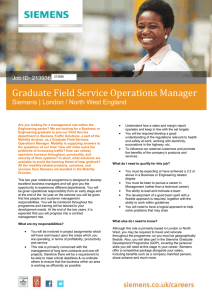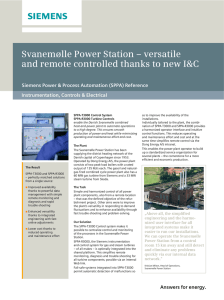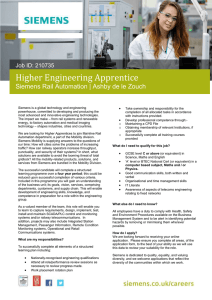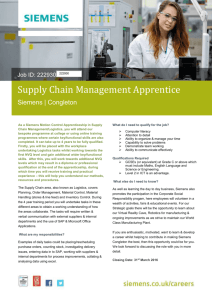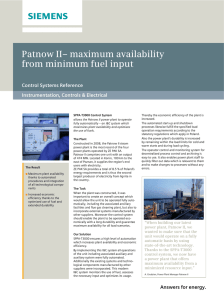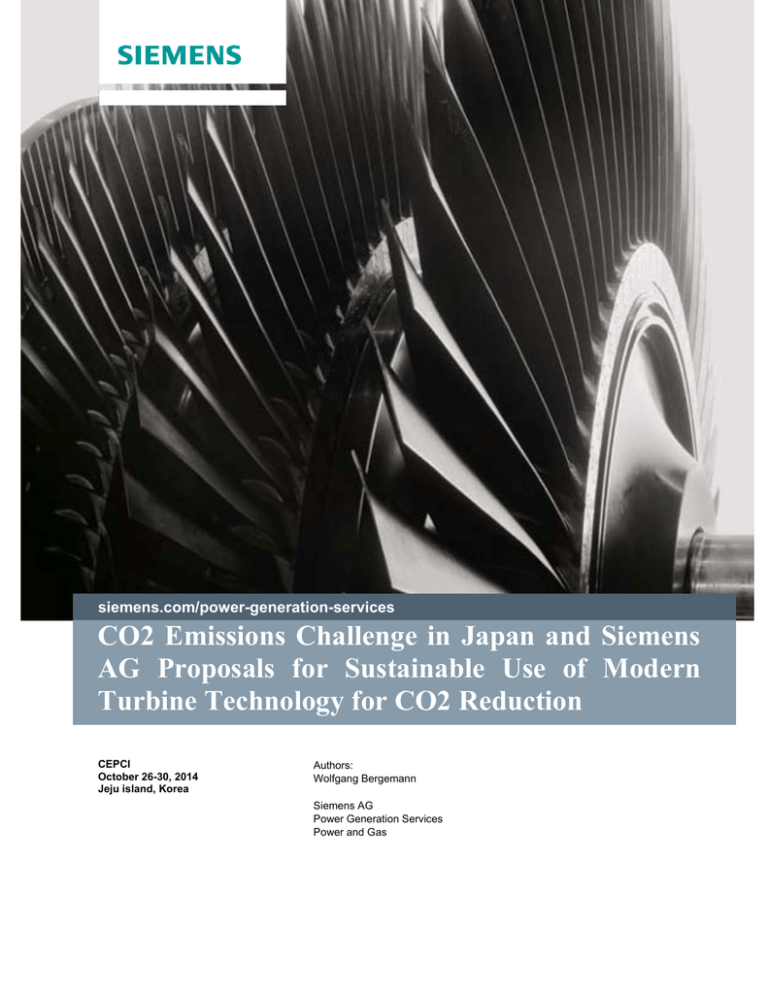
siemens.com/power-generation-services
CO2 Emissions Challenge in Japan and Siemens
AG Proposals for Sustainable Use of Modern
Turbine Technology for CO2 Reduction
CEPCI
October 26-30, 2014
Jeju island, Korea
Authors:
Wolfgang Bergemann
Siemens AG
Power Generation Services
Power and Gas
Table of Contents
1. Introduction ........................................................................ 3 2. Method................................................................................. 3 3. Modernization of the HP/IP Turbine BB 44 .................... 4 3.1 Reliability issues ................................................................. 4 3.2 Blade design ........................................................................ 4 3.3 Modernization solutions..................................................... 5 4. Modernization of the LP Turbine Type BB 73 ................ 8 4.1 Reliability issues ................................................................. 8 4.2 Blade design ........................................................................ 9 4.3 Modernization solution .................................................... 10 5. Conclusion ......................................................................... 11 6. References ......................................................................... 12 7. Disclaimer ......................................................................... 13 AL: N; ECCN: N
Unrestricted © Siemens AG 2014. All rights reserved.
Page 2 of 14
1.
Introduction
After the massive tsunami tragedy in Fukushima in March 2011, Japan shut down all nuclear
power. Hence the entire existing fleet of more than 110 GW fossil fuel power plants, in
addition to the hydropower plants and some wind and solar plants, were faced with covering
the entire electricity demand. Due to this, the CO2 emissions intensity in Japan has increased.
One of the measures for environmental conservation, including countermeasures against
global warming, is modernizing fossil power plant turbines by increasing efficiency or
reducing fuel consumption at same output.
If requested, Siemens Energy can contribute toward overcoming this challenge with their
modern, state-of-the-art technology for blades, seals and casing design, especially for the fleet
built by MHI under a Westinghouse license. Based on our experiences with turbine
modernizations on Westinghouse units in the US, Mexico, Thailand and the United Kingdom
of Saudi Arabia, we can offer wide a variety of products for these MHI units combined with
low outage durations and extended maintenance intervals.
Siemens already has experience with modernizing MHI-manufactured units in Japan after
very successfully modernizing both NPP Sendai 1 & 2 turbines in 2006 and 2010.
2.
Method
One of the best methods for reducing CO2 emissions is modernizing the turbine. The success
of this approach can be guaranteed when the modernization results in a reduction of fuel
consumption while keeping same output, but achieved with a lower steam flow rate or output
improvement with same steam flow rate. A 1% efficiency improvement of a 500 MW coalfired power plant saves up to 35,000 t of carbon dioxide (CO2) per year.
Turbine modernization also remedies all known reliability issues. This can be achieved
mainly by replacing main components such as rotors and inner casings and reusing existing
outer casings. Using all of the knowledge from Westinghouse Building Block (BB) design
and the latest Siemens blade design, the target can be met. This paper uses the turbine
modernization of the HP/IP Turbine BB 44 and LP Turbine BB 73 as examples of our wide
range of capabilities and experience which describe a typical ~ 500MW unit.
AL: N; ECCN: N
Unrestricted © Siemens AG 2014. All rights reserved.
Page 3 of 14
3.
Modernization of the HP/IP Turbine BB 44
3.1 Reliability issues
Based on technical knowledge and design criteria from decades ago we are now experiencing
some technical issues with units operating on a long-term basis as shown in Fig. 1.
Fig. 1
3.2 Blade design
The blade design is based on Siemens AG blade design with its famous 3DS/ DV Blades,
shown in Fig. 2, which were developed in the late nineties. This blade design has been used
for several turbine modernizations and was adopted for new apparatus designs.
All newly manufactured or erected steam turbine plants in last 15 years use this highly
efficient design.
AL: N; ECCN: N
Unrestricted © Siemens AG 2014. All rights reserved.
Page 4 of 14
Fig. 2
3.3 Modernization solutions
Based on our and customer requests, Siemens has developed two different solutions. One for
base load operated units or so-called “full arc admissions” and one for load-following and
two-shift operation or a so-called “partial arc solution” shown in Fig. 3, 4, 5. Fig. 5 also
shows some expected thermodynamic numbers.
AL: N; ECCN: N
Unrestricted © Siemens AG 2014. All rights reserved.
Page 5 of 14
Fig. 3
Fig. 4
AL: N; ECCN: N
Unrestricted © Siemens AG 2014. All rights reserved.
Page 6 of 14
Fig. 5
The proposed solution shows feasibilities, especially for efficiency improvements which can
be converted into lower fuel consumption while keeping same output. Siemens also
developed new strategy to shorten the outage duration as a maintenance cost-saving measure.
The main driver has been the reuse of existing outer casing and pipes and extractions.
Shown here in Fig. 6:
AL: N; ECCN: N
Unrestricted © Siemens AG 2014. All rights reserved.
Page 7 of 14
Fig. 6
4.
Modernization of the LP Turbine Type BB 73
4.1 Reliability issues
Based on technical knowledge and design criteria from decades ago we are now experiencing
some technical issues with units operating on a long-term basis as shown in Fig. 7. Especially
the Stress Corrosion Cracking (SCC) history is important due to the fact that Siemens has
strived to find out the root cause of the occurrence of SCC and has developed sufficient
measures to avoid SCC. Today, Siemens has gone more than 2 decades without any SCC on
rotors manufactured by Siemens.
AL: N; ECCN: N
Unrestricted © Siemens AG 2014. All rights reserved.
Page 8 of 14
Fig. 7
4.2 Blade design
For our LP blade design, we use our 3DS blades for the drum stages. For the last stages L-0,
L-1 and L-2, Siemens uses a standardized stage package specifically designed and, generally
free-standing, finely-tuned L-0 blades and shrouded L-1, L-2 blades without damping wires or
snubbers. For efficiency reasons, with some specific solutions, we offer also shrouded L-0
solution. An overview of the key technologies is shown in Fig. 8.
AL: N; ECCN: N
Unrestricted © Siemens AG 2014. All rights reserved.
Page 9 of 14
Fig. 8
4.3 Modernization solution
The newly developed modernization solution has been implemented more than 45 times in the
last couple of years. The most recent version of this 8.7m² rotor with 37.6 inch blade in the
last stage blade (LSB) is very successful, reliable and very efficient. As shown in Fig. 9, all
colored components were replaced by reusing existing outer casings. If the last stage blade
has a larger area or heavier weight, all interferences would be taken into account and solved
with a Design Analysis Report (DAR) which will be forwarded to customers.
Thermodynamic evaluation shows potential of up to 3 – 5 MW per LP or, again, the same
output with a lower steam flow rate.
AL: N; ECCN: N
Unrestricted © Siemens AG 2014. All rights reserved.
Page 10 of 14
Fig. 9
5.
Conclusion
Modernizing aging steam turbines with state-of-the-art technologies can improve turbine
efficiency in general by five to six percent. Depending on the age of the design and operating
time this can sometimes be even higher. Combined with the chance of fixing reliability issues,
this method results in a high probability of reducing CO2 emissions as well as increasing the
service life and improving competitiveness. Due to the extension of inspection intervals up to
100,000 operating hours, maintenance costs can also be reduced.
AL: N; ECCN: N
Unrestricted © Siemens AG 2014. All rights reserved.
Page 11 of 14
6.
References
Jansen, M.; Ulm, W. (1995): Modern Blade Design for Improving Steam Turbine Efficiency,
1st European Conference on Turbomachinery, Fluid Dynamic and Thermodynamic Aspects,
University Nürnberg-Erlangen
Simon, V.; Stephan, I.; Bell, R.M.; Capelle, U.; Deckers, M.; Schnaus, J.; Simkine, M.
(1997): Axial Steam Turbines with Variable Reaction Blading, Advances in Turbine
Materials, Design and Manufacturing, Proceedings of the 4th International Charles Parsons
Conference, London
Harig, T.; Oeynhausen, H.; Turbine upgrades - Economic and technical potentials for
conventional and nuclear plants; Reprint from BWK, March 2005
Siemens User Meetings and Siemens presentation materials
AL: N; ECCN: N
Unrestricted © Siemens AG 2014. All rights reserved.
Page 12 of 14
7.
Disclaimer
These documents contain forward-looking statements and information – that is, statements
related to future, not past, events. These statements may be identified either orally or in
writing by words as “expects”, “anticipates”, “intends”, “plans”, “believes”, “seeks”,
“estimates”, “will” or words of similar meaning. Such statements are based on our current
expectations and certain assumptions, and are, therefore, subject to certain risks and
uncertainties. A variety of factors, many of which are beyond Siemens’ control, affect its
operations, performance, business strategy and results and could cause the actual results,
performance or achievements of Siemens worldwide to be materially different from any
future results, performance or achievements that may be expressed or implied by such
forward-looking statements. For us, particular uncertainties arise, among others, from changes
in general economic and business conditions, changes in currency exchange rates and interest
rates, introduction of competing products or technologies by other companies, lack of
acceptance of new products or services by customers targeted by Siemens worldwide,
changes in business strategy and various other factors. More detailed information about
certain of these factors is contained in Siemens’ filings with the SEC, which are available on
the Siemens website, www.siemens.com and on the SEC’s website, www.sec.gov. Should one
or more of these risks or uncertainties materialize, or should underlying assumptions prove
incorrect, actual results may vary materially from those described in the relevant forwardlooking statement as anticipated, believed, estimated, expected, intended, planned or
projected. Siemens does not intend or assume any obligation to update or revise these
forward-looking statements in light of developments which differ from those anticipated.
Trademarks mentioned in these documents are the property of Siemens AG, its affiliates or
their respective owners.
AL: N; ECCN: N
Unrestricted © Siemens AG 2014. All rights reserved.
Page 13 of 14
Published by and copyright © 2015:
Siemens AG
Freyeslebenstrasse 1
91058 Erlangen, Germany
Siemens Energy, Inc.
4400 Alafaya Trail
Orlando, FL 32826-2399, USA
For more information, please contact
our Customer Support Center.
Phone: +49 180/524 70 00
Fax:
+49 180/524 24 71
(Charges depending on provider)
E-mail: support.energy@siemens.com
All rights reserved.
Trademarks mentioned in this document are
the property of Siemens AG, its affiliates,
or their respective owners.
AL: N; ECCN: N
Subject to change without prior notice.
The information in this document contains
general descriptions of the technical options
available, which may not apply in all cases.
The required technical options should therefore
be specified in the contract.
Unrestricted © Siemens AG 2014. All rights reserved.
Page 14 of 14





